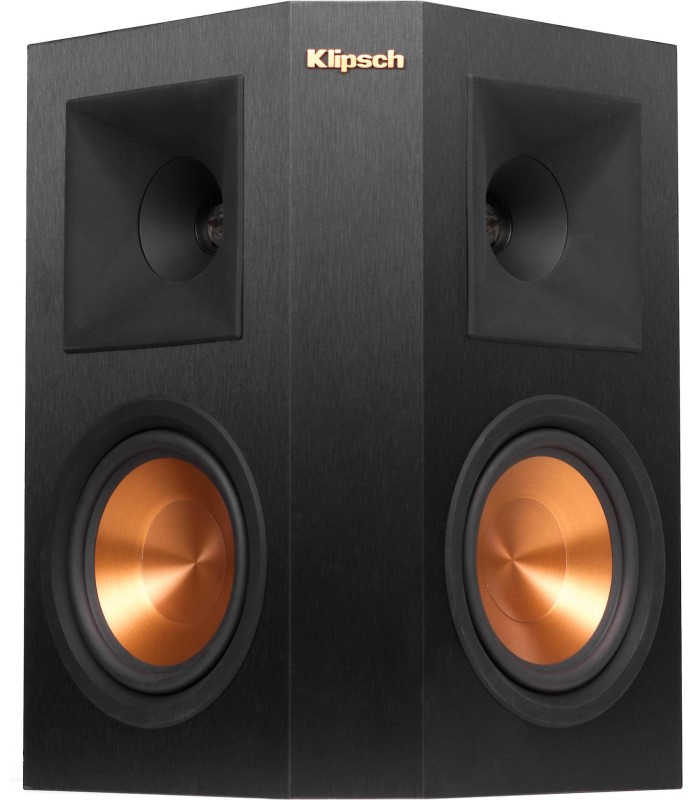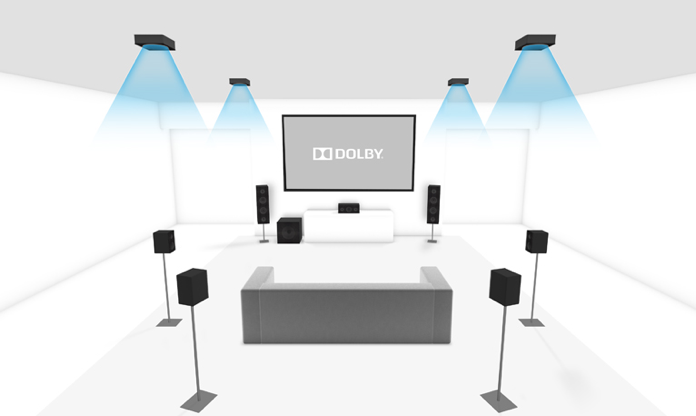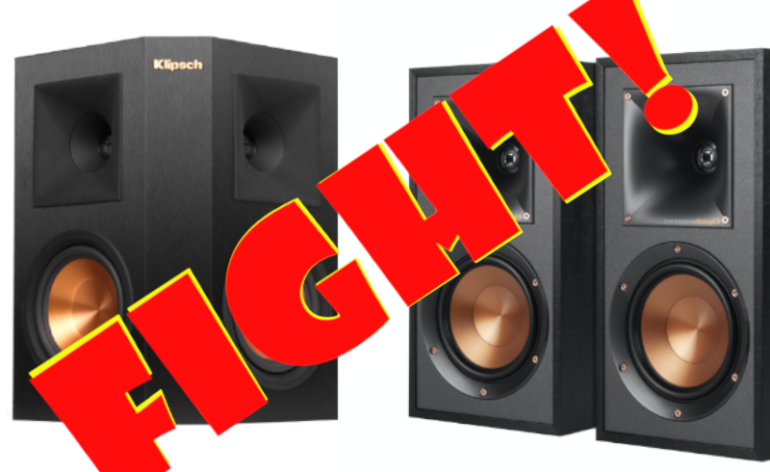Best Type of Surround Speaker for Atmos
When you shop for speakers for your home theater, you’ll find some labeled “surround speakers.” These can look like small bookshelf speakers or they can look like some sort of weird trapezoid with drivers pointed out at angles. You’ll hear the words “bi-pole,” “di-pole,” and others thrown around. Dolby Atmos and DTS:X are new surround formats that have specific requirements. Which type of surround speaker is best for Atmos? Well, surround speaker type recommendations have changed over the years.
Pre-Atmos
Dolby Atmos is, among other things, a surround sound format that includes overhead speakers. Atmos is fairly new to the point that you’d be forgiven if this is the first you’ve heard of it. At the time of this writing, consumer-level receivers top out at a max of six overhead speakers with most topping out at four.
Before the release of Atmos a couple of years ago, home theater systems could have, at most, seven speakers. At least, this applied to most people. We know about front wides, Yamaha presence speakers, and others—but those never really caught on with most users. At that time, the recommended positioning for side surround speakers was above your head to each side and several feet behind you. Back-wall placement was often a common placement in a five-speaker system.
Surround back speakers had two placement options. Dolby and DTS recommended placing the Surround Back speakers far apart on the back wall. They provided no real guidelines as to exactly how far, however. THX suggested placing them on the back wall but fairly close together (within a few feet). In both cases, both formats wanted the surround back speakers placed higher on the wall. By “higher” they usually meant as high, or higher, than the surrounds.
Diffuse Sound Was King
In the Pre-Atmos era, we talked a lot about diffuse sound. Movie theaters position multiple speakers on the sidewalls very far away from you. This creates a very diffuse sound field. You can’t easily pinpoint side information. To replicate this, manufacturers started making side surround speakers that had multiple drivers facing in different directions.

You can configure these types of speakers in different ways. When all the speaker drivers fire in-phase, they are called bi-pole. If the drivers fire out-of-phase, we called them di-pole. Some had a switch on the back that would switch the speaker from one to the other. Regardless, the idea was to recreate that diffuse sound found in movie theaters.
Editor’s Note: It may help to remember that “di” pole speakers fire different signals (out of phase) while “bi” pole speakers both fire together in the same phase. D = different. B = both. You’re welcome.
Monopole (regular bookshelf) speakers were usually recommended for surround back duty. Some people put the bi/di-pole speakers for surround back speakers as well. The thought was that the orientation of the speaker (behind your head) meant that the sound would be suitably diffuse. Or maybe it was so that you could more easily pick out the surround back speakers as compared to the side surrounds. Either way, the recommended speaker configuration was bi/di-pole speakers for side surrounds, monopoles for surround backs.
Post-Atmos

After Atmos was released, Dolby radically changed their suggestions for the best speaker types and configurations for surround sound. Instead of the side surround and surround back speakers being elevated, they were now positioned close to ear level. This was a big departure from previous advice. Also, the surround back speakers were now to be placed in line with the front speakers. The overhead speakers, no matter what position, were also to be in line with the front speakers and surround backs. The only speakers out of line with these would be the center (under the display), subs, and side surrounds. The side surrounds were now recommended to be as close to directly to the sides of your couch as possible. Again, near ear level.
When you examine what Atmos is trying to do, these new recommendations make sense. Keeping the floor-level speakers at near ear level gives more physical separation between them and the overheads. Many home theaters are in normal-sized rooms with eight-foot ceilings. Basements, with sometimes lower ceilings, are also common for home theaters. The more separation between the floor-level and ceiling speakers the better.
Side Surround Dispersion vs Point-Source
The real change came in the recommendations for the side surround speakers. While before Dolby was perfectly fine with people installing bi/di-pole speakers for side surround, now they insist on monopoles. Again, if we look at Atmos as a sound format, it makes sense. Atmos (as well as DTX:X and Auro 3D) is an object-based format.
While before, sound mixers would put sound in each speaker individually, Atmos uses computers to place the sound in a 3D space. The processor in your receiver then uses the information about the number and positions of speakers in your room to try to recreate that sound in your room. While before the sound editor would try to do that using phase and other techniques, with Atmos they only need to know where they want to sound to be and let the hardware do the rest.
This technology demands that speakers be able to image properly. A diffuse speaker is, by definition, unable to be located. When placing sounds in a 3D space, diffuse sounds just don’t work. Instead, Atmos needs each speaker to be able to be located if needed. Thus the switch to monopoles all the way around.
The Ultimate Winner is Determined By Dolby?
In the end, Dolby is really the one that decides what speaker type is best for recreating the surround sound experience in your Atmos home theater. And it isn’t for the reason you think. Dolby can put out all the guidelines they want for home placement. And that is all they are. Where the real difference is made is in how movies are mixed.

Dolby’s guidelines aren’t just for home users. In the past, sound editors could use diffuse speakers in their studios. To properly mix an Atmos soundtrack, the sound editor now must have a properly set up Atmos system.
That means monopole speakers at the proper heights and elevations (they even talk about polarities). In the end, this is what should inform your home theater speaker choices. You want to hear what the sound editor intended. To do that, you’ll need a similar speaker layout. That means monopoles in the Dolby recommended positions.
Should I Run Out and Buy New Speakers?
The last thing I want you to do is to walk into your completed theater and somehow think it is now substandard. If you have a dedicated theater and already have bi/di-pole speakers on the walls, don’t worry. If your current speakers have the option, switch them to bi-pole mode. Thinking of adding Atmos speakers? Consider getting some inexpensive in-ceiling speakers from Monoprice or the Prime Elevation speakers from SVS. Atmos speakers don’t have to be expensive to work effectively.
Once you’ve settled into your new Atmos setup, you can decide if the diffuse side surrounds are hurting your experience. Our guess is that you won’t feel that way. But, if you do, you know what to change.



Whilst I agree that direct speakers work best most of the time for modern sound formats, however if you have limited space, and the sofa is pushed up against a rear wall, dipole speakers can still make an excellent choice for surround speakers. I complement my KEF R300 (front left/right) and KEF R200c (centre) with a pair of KEF R800ds and they work really well in this environment.
We usually recommend bi over di-pole because of the null the di-pole speakers can create. That said, they do create a more diffuse sound.
I am currently relocating my surround room to a smaller room downstairs. The couch is against the side and back walls. I was looking at the Klipsch Atmos Speaker system and was going to utilize the Di Pole or Bi Pole for my Surrounds and Rear Surrounds. The speakers will have to be hung above ear height due to couch. I am now rethinking this decision after this article. Any advice would be greatly appreciated.
The dipole speaker would work best as a side surround if you have a little space behind the couch. With the couch being on the back wall, you will want to consider a couple of options, all of which assume the speaker mounted on the side walls or to the sides of the couch.
1) Dipole speaker but put some absorptive material on the back wall near to speaker to catch the reflection.
2) An angled direct fire speaker (like the SVS Prime Elevation).
3) A regular satellite speaker mounted fairly high but pointed directly into the room.
Again, with each of these speakers, if they are mounted very close to the back wall, you’ll want to put absorptive material on the back wall to catch the reflection.
In all cases, I would recommend against the back surrounds. You should just run a 5.X system with your couch on the back wall. The back surrounds will not have enough separation from the side surrounds and will muddy the surround sound. They will effectively be above your head. You need at least five feet of space (my rule of thumb) before surround back speakers make sense.
Hope this helps.